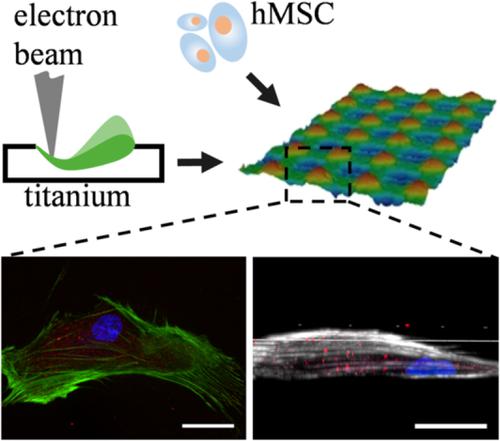当前位置:
X-MOL 学术
›
J. Biomed. Mater. Res. Part B Appl. Biomater.
›
论文详情
Our official English website, www.x-mol.net, welcomes your feedback! (Note: you will need to create a separate account there.)
Enhanced osteogenic differentiation of human mesenchymal stromal cells as response to periodical microstructured Ti6Al4V surfaces.
Journal of Biomedical Materials Research Part B: Applied Biomaterials ( IF 3.4 ) Pub Date : 2020-01-25 , DOI: 10.1002/jbm.b.34559 Simon Janßen 1 , Stefan Gach 2 , Sebastian Kant 3 , Sanja Aveic 1, 4 , Stephan Rütten 5 , Simon Olschok 2 , Uwe Reisgen 2 , Horst Fischer 1
Journal of Biomedical Materials Research Part B: Applied Biomaterials ( IF 3.4 ) Pub Date : 2020-01-25 , DOI: 10.1002/jbm.b.34559 Simon Janßen 1 , Stefan Gach 2 , Sebastian Kant 3 , Sanja Aveic 1, 4 , Stephan Rütten 5 , Simon Olschok 2 , Uwe Reisgen 2 , Horst Fischer 1
Affiliation

|
Titanium‐based alloys, for example, Ti6Al4V, are frequently employed for load‐bearing orthopedic and dental implants. Growth of new bone tissue and therefore osseointegration can be promoted by the implant's microtopography, which can lead to improved long‐term stability of the implant. This study investigates the effect that an organized, periodical microstructure produced by an electron beam (EB) technique has on the viability, morphology, and osteogenic differentiation capacity of human mesenchymal stromal cells (hMSC) in vitro. The technique generates topographical features of 20 μm in height with varying distances of 80–240 μm. Applied alterations of the surface roughness and local alloy composition do not impair hMSC viability (>94%) or proliferation. A favorable growth of hMSC onto the structure peaks and well‐defined focal adhesions of the analyzed cells to the electron beam microstructured surfaces is verified. The morphological adaptation of hMSC to the underlying topography is detected using a three‐dimensional (3D) visualization. In addition to the morphological changes, an increase in the expression of osteogenic markers such as osteocalcin (up to 17‐fold) and osteoprotegerin (up to sixfold) is observed. Taken together, these results imply that the proposed periodical microstucturing method could potentially accelerate and enhance osseointegration of titanium‐based bone implants.
中文翻译:

作为对周期性微结构 Ti6Al4V 表面的响应,增强人间充质基质细胞的成骨分化。
钛基合金,例如 Ti6Al4V,经常用于承载骨科和牙科植入物。植入物的微地形可以促进新骨组织的生长,从而促进骨整合,从而提高植入物的长期稳定性。本研究调查了电子束 (EB) 技术产生的有组织的周期性微观结构对体外人间充质基质细胞 (hMSC) 的活力、形态和成骨分化能力的影响。该技术生成高度为 20 μm 且距离为 80-240 μm 的地形特征。表面粗糙度和局部合金成分的应用改变不会损害 hMSC 的生存能力 (>94%) 或增殖。验证了 hMSC 在结构峰上的有利生长,以及分析细胞与电子束微结构表面的明确粘着斑。使用三维 (3D) 可视化检测 hMSC 对底层地形的形态适应性。除了形态学变化外,还观察到成骨标志物如骨钙素(高达 17 倍)和骨保护素(高达 6 倍)的表达增加。综上所述,这些结果表明所提出的周期性微观结构方法可能会加速和增强钛基骨植入物的骨整合。除了形态学变化外,还观察到成骨标志物如骨钙素(高达 17 倍)和骨保护素(高达 6 倍)的表达增加。综上所述,这些结果表明所提出的周期性微观结构方法可能会加速和增强钛基骨植入物的骨整合。除了形态学变化外,还观察到成骨标志物如骨钙素(高达 17 倍)和骨保护素(高达 6 倍)的表达增加。综上所述,这些结果表明所提出的周期性微观结构方法可能会加速和增强钛基骨植入物的骨整合。
更新日期:2020-01-25
中文翻译:

作为对周期性微结构 Ti6Al4V 表面的响应,增强人间充质基质细胞的成骨分化。
钛基合金,例如 Ti6Al4V,经常用于承载骨科和牙科植入物。植入物的微地形可以促进新骨组织的生长,从而促进骨整合,从而提高植入物的长期稳定性。本研究调查了电子束 (EB) 技术产生的有组织的周期性微观结构对体外人间充质基质细胞 (hMSC) 的活力、形态和成骨分化能力的影响。该技术生成高度为 20 μm 且距离为 80-240 μm 的地形特征。表面粗糙度和局部合金成分的应用改变不会损害 hMSC 的生存能力 (>94%) 或增殖。验证了 hMSC 在结构峰上的有利生长,以及分析细胞与电子束微结构表面的明确粘着斑。使用三维 (3D) 可视化检测 hMSC 对底层地形的形态适应性。除了形态学变化外,还观察到成骨标志物如骨钙素(高达 17 倍)和骨保护素(高达 6 倍)的表达增加。综上所述,这些结果表明所提出的周期性微观结构方法可能会加速和增强钛基骨植入物的骨整合。除了形态学变化外,还观察到成骨标志物如骨钙素(高达 17 倍)和骨保护素(高达 6 倍)的表达增加。综上所述,这些结果表明所提出的周期性微观结构方法可能会加速和增强钛基骨植入物的骨整合。除了形态学变化外,还观察到成骨标志物如骨钙素(高达 17 倍)和骨保护素(高达 6 倍)的表达增加。综上所述,这些结果表明所提出的周期性微观结构方法可能会加速和增强钛基骨植入物的骨整合。



























 京公网安备 11010802027423号
京公网安备 11010802027423号